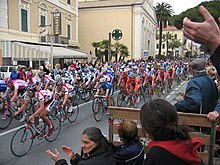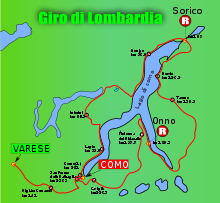Classic (cycling)




One- day races that are particularly important and rich in tradition are described as classics in road cycling .
Although the term classic in cycling is neither protected nor precisely defined, several traditional factors can be named that are decisive for the prestige of cycling races: the year of the first event - if possible before the First World War -, a high number of events, a during the various conditions largely unchanged, the requirements typical ("classic") route, the public recognition and the quality of the winners list.
Racers who are successful in classics are often referred to as classics hunters.
"Monuments of cycling"
Characteristic
The most important classics are the five “monuments of cycling”, all of which were held for the first time before the First World War and feature a Palmarès with numerous well-known winners. Each of these races has a special characteristic: Milan – Sanremo (“la Classicissima” or “la Primavera”) is often decided in favor of the sprinters on the Italian Riviera . The Tour of Flanders ("de ronde" or "vlaanderens mooiste") is characterized by short, steep climbs on cobblestones , the Hellingen . Paris – Roubaix (“l'Enfer du Nord” or “La Reine des Classiques”) is completely flat and draws its particular difficulty from the approximately 50 kilometers of often extremely rough cobblestone passages, the Pavés . The oldest monument, Liège – Bastogne – Liège (“la doyenne”), takes place in the Walloon Ardennes with numerous steep, mostly shorter, but sometimes up to four kilometers long climbs. While these four classics are held in spring at the beginning of the cycling season, one of the last races of the season is the Lombardy Tour (“la classica delle foglie morte”), which is tailored to more mountainous riders.
Palmarès
Only three cyclists have managed to win at least once in all five races, all of them come from Belgium: First, Rik Van Looy succeeded in doing this , who achieved a total of eight victories between 1958 and 1965. After that Eddy Merckx (between 1966 and 1976) and Roger De Vlaeminck (between 1970 and 1979) won all one-day races. De Vlaeminck won a total of eleven times in a classic, Merckx won a total of 19 times (and at least twice in each race).
| run | First run | current distance | Record winner | meeting |
|---|---|---|---|---|
|
|
1907 | 291 km |
|
March |
|
|
1913 | 260 km |
|
April |
|
|
1896 | 257 km |
|
April |
|
|
1892 | 258 km |
|
April |
|
|
1905 | 254 km |
|
October |
Other classics, semi-classics and modern classics
In general, Paris – Tours is also counted among the classics , although the name and route of the race changed a few times. The classic status is disputed. a. for Omloop Het Nieuwsblad (until 2008: Omloop Het Volk), Gent – Wevelgem , La Flèche Wallonne , Amstel Gold Race , Clásica San Sebastián , Brussels Cycling Classic, formerly: Paris – Brussels , Piedmont Tour and Milan – Turin . These and other races are often "only" viewed as " semi-classics ", as some of the criteria mentioned for classic races are wholly or partially not present in these races. The term modern classics is also used for important races of more recent founding dates, such as the Clásica San Sebastián, Eschborn – Frankfurt and the Zurich championship, which has now been set for professionals ; this could include the Amstel Gold Race, which was held for the first time in 1966.
Bordeaux – Paris , which took place in the years 1891–1988, was a specialty . It ran for about 600 km, but lost its importance since the 1960s.
Spring and autumn classics
Most of the classics predominantly take place during two different periods:
In March and April, the so-called spring classics are held in Belgium and northern France in particular , which include the monuments Milan-Sanremo, Tour of Flanders, Paris-Roubaix and Liège-Bastogne-Liège, the Amstel Gold Race and the semi-classics Gent-Wevelgem and Flèche Wallonne are counted. They are often characterized by cobblestone passages (pavés or cash desks), steep and short climbs, as well as strong weather influences.
The autumn classics will follow in the second half of the year , to which one can count due to the timing of the Brussels Cycling Classic, Paris Tours and the Lombardy Tour.
German and Swiss classics
In Germany, the cycle races around Berlin (since 1896), around the Hainleite (since 1907), around Cologne (since 1908) and Eschborn-Frankfurt (from 1962 to 2008 under the name "Around the Henninger Tower") ) referred to as a "classic". While “Rund um Berlin”, “Rund um die Hainleite” and “Rund um Köln” derive their prestige primarily from their age, the Frankfurt race, on the other hand, is assigned the status of a classic mainly because of its sporting importance. As with other traditional German and international races, whether these races are classics or semi-classics is a question of subjective assessment. The Cyclassics Hamburg are against it, contrary to its name and despite their classification in the UCI World Tour and the resulting excellent occupation probably not a classic, as they were held for the first time only in the year 1996th
Numerous traditional Swiss one-day races are also described as classics, in addition to the Zurich championship, for example. B. the Berner Rundfahrt (from 1921 to 1991: Nordwestschweizer Rundfahrt, renamed the Berner Rundfahrt in 1992 ) and the Grand Prix of the Canton of Aargau in Gippingen (since 1964).
Popular sports classics
Organizers and some cycling enthusiasts also host important mass sport events such as cycling marathons , cycling tours and races for everyone , e.g. B. Limburgs Mooiste , De Hel van Twente , Paris – Brest – Paris or the Alpenbrevet , known as cycling classics .
See also
Web links
References and comments
- ↑ similar to this: "Die Radsportklassiker" on strassenradsport.com ( Memento of the original from April 9, 2011 in the Internet Archive ) Info: The archive link has been inserted automatically and has not yet been checked. Please check the original and archive link according to the instructions and then remove this notice. , accessed April 3, 2011
- ↑ Rolf Gölz : Myth Classic. A homage to the great one-day races. (With photos by Hans-Alfred Roth ). Covadonga-Verlag, Bielefeld 2003, ISBN 3-936973-01-6 , p. 6.
- ↑ The term is u. a. required by the World Cycling Association UCI , cf. UCI press release of June 18, 2010: Second day of the UCI Management Committee meeting (English / French) ( Memento of the original of December 24, 2011 in the Internet Archive ) Info: The archive link has been inserted automatically and has not yet been checked. Please check the original and archive link according to the instructions and then remove this notice. which, however, includes the Grand Tours in the term here.
- ↑ classicissima = it. Form of increase of "classic", la Primavera = "spring"
- ↑ ned. for "the round" or "Flanders most beautiful"
- ↑ French "the hell of the north" or "the queen of the classics"
- ↑ French "the longest serving" or "the honorable ones"
- ↑ it. "Classic of dead leaves", usually translated as "race of falling leaves"
- ↑ Top-5: The monuments of cycling - and their peculiarities. n24.de, March 21, 2015, accessed on March 23, 2015 .
- ↑ The race was sometimes called the Grand Prix d'Automne (German: Great Autumn Prize) or after the changing start and finish locations. It was held differently from today's name on the following routes: Tours – Versailles (1974–75), Blois – Chaville (1976/77 and 1979–1984), Blois – Autodrome de Montlhéry (1978) and Créteil – Chaville (1985–1987) .
- ↑ z. B. sport.freenet.de from March 27, 2011: Semi-classic Gent-Wevelgem: Tom Boonen wins the sprint
- ↑ Philippe Bouvet, Philippe Brunel, Pierre Callewaert, Jean-Luc Gatellier, Serge Laget: Classic of cycling. The big one-day races. Delius Klasing, Bielefeld 2008, ISBN 978-3-7688-5270-8 , p. 148 ff.
- ↑ for classification as a classic, cf. z. B. Gilbert Duclos-Lassalle - Like a good wine on radsport-seite.de accessed on November 23, 2014
- ↑ cf. Tour service: The spring classics 2014 on tour-magazin.de accessed on November 23, 2014
- ↑ radsport-news.com from March 24, 2013: Spring classic in freezing cold
- ↑ cf. radsport-news.com of March 17th, 2014: La Flèche de Wallonie: the "arrow" flies for everyone
- ↑ on the use of the term autumn classics cf. z. B. rad-net.de from October 13, 2013: Results from the autumn classic Paris-Tours
- ↑ cf. news.de from March 30, 2011: German bike selection at “Around Cologne” at the start ( Memento of the original from September 13, 2016 in the Internet Archive ) Info: The archive link was automatically inserted and not yet checked. Please check the original and archive link according to the instructions and then remove this notice.
- ↑ cf. Freiepresse.de from May 1, 2010: Wegmann wins Frankfurt classic bike again
- ^ Kurt Graunke , Walter Lemke, Wolfgang Rupprecht: Giants from then to now. The history of the German professional road cyclists. Names, successes, anecdotes. Edition Sedina, Munich 1993, ISBN 3-9803273-0-2 , p. 6.
- ↑ cf. for the Alpenbrevet : rad-net.de from August 30, 2012 Fully booked: Saturday the classic "Alpenbrevet" rad-net.de from August 30, 2012

